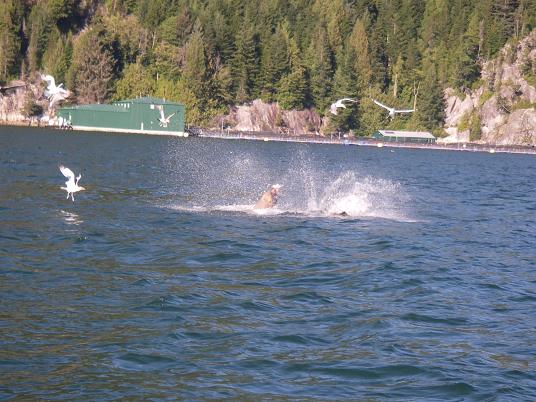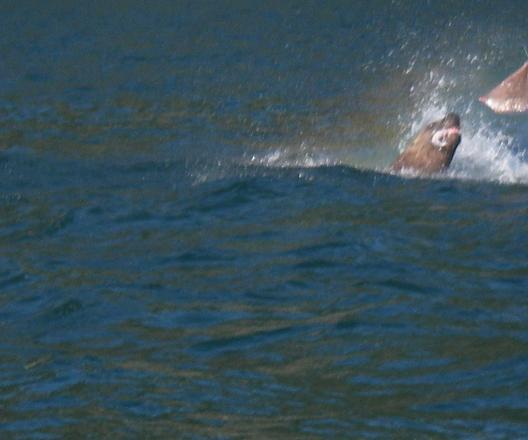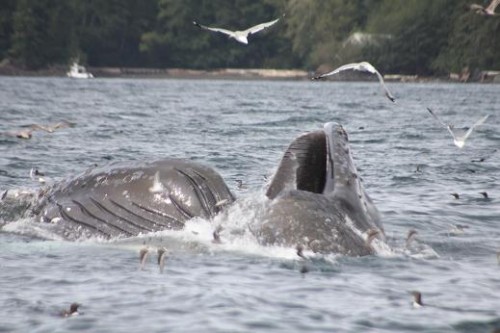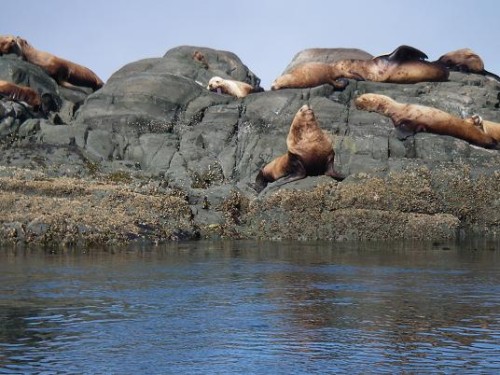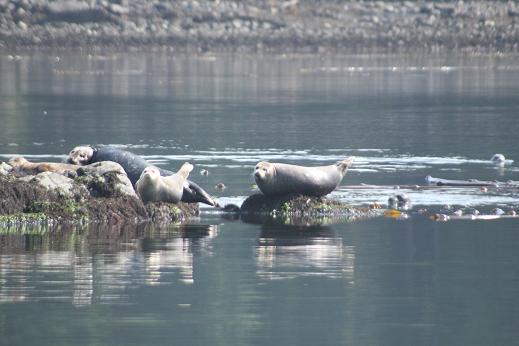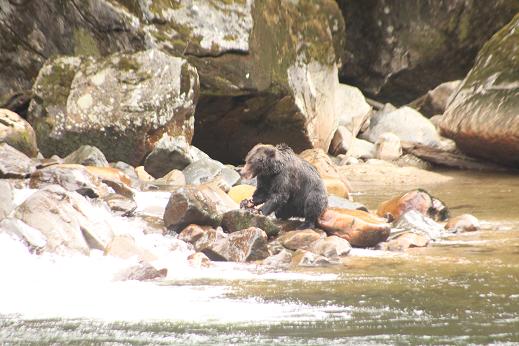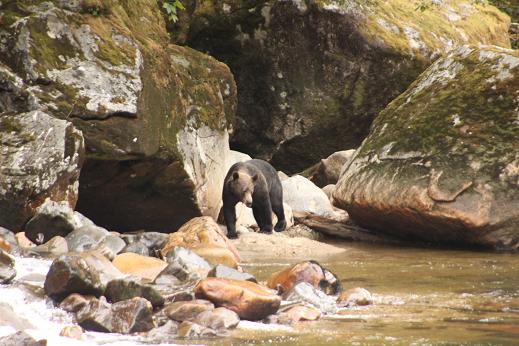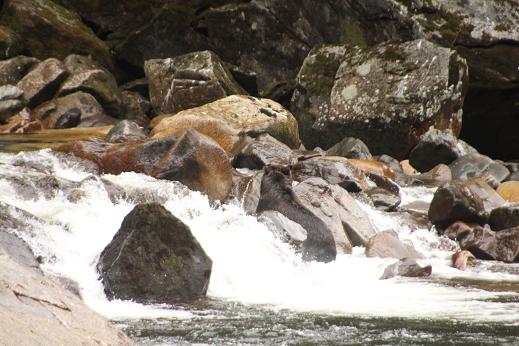Humpback whales are identified by the underside and trailing edge of their tail flukes; each one is different just like a fingerprint. In British Columbia humpbacks are given a letter as part of their identification to categorize their fluke based on color. X animals have mostly black tails with less than 20% white on their fluke, Y animals have a fluke that is 20-60% white, while Z animals have more than 60% of their fluke white. Humpback whales often show these tails, or ‘fluke’ while diving, making them ideal candidates for photo-identification projects. This photo is of a humpback that we frequently see on our whale watching tours, it is called ‘Guardian’.
Grizzly Bear and Wildlife Tour Blog
We offer an exceptional fly-in lodge for Grizzly Bear Watching and Whale Watching in British Columbia.
Learn about What’s happening at the Lodge, view our British Columbia’s Wildlife Report, read our Grizzly Bear Watching Blog and Whale Watching Blog. Learn more about a Day on the River Blog, see Our Tour Guide’s Photos & Blog and Photos from Our Guests.
Steller sea lion feeding on salmon?
Steller sea lions on the BC coast most often catch and eat their food under water however if it is larger then they come to the surface. The process has the sea lion whipping their head back and forth until they rip a mouthful out of their catch. Once that is swallowed they dive down and pick up the catch and repeat the performance until it is all consumed. The first photo shows the whipping process and the second is all I could get of a close up of the sea lion with a mouthful. From the second photo this appears to be a halibut or some other flounder style fish.
Bald Eagle with salmon
Spending the hours we do in the boat on our tours from the lodge we frequently see bald eagles on the shore eating their catch. In this case the catch is a pink salmon we saw it pick from the water a few minutes earlier. Until the salmon arrive in the rivers the eagles are more concentrated in the Johnstone Strait area where there is an abundance of herring which are a little easier to catch than salmon. If you have time to Google “Eagle Myths – State of Alaska” you will find one of the best article I have read on a bald eagles lifting powers “Eagle Flight and Other Myths Eagles Don’t Eat Children or Pets By Riley Woodford”. Short version: “best estimates put the lifting power of an eagle at four or five pounds.” The full article is definitely worth the time.
Grizzly lesson learned
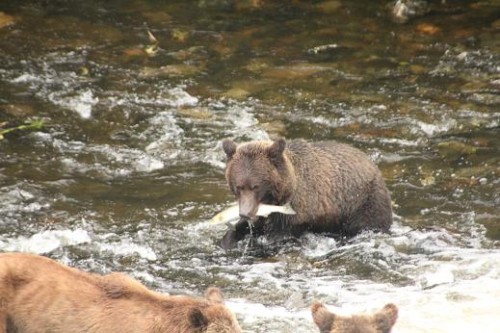
This could be this two-year-old grizzly bear cub’s first salmon. It was the first day that we noticed it had much interest in fishing. Prior to this it relied on it’s mother to provide the food. Time to become an active member of the family and obtain it’s own meals. There is a good chance that this is the last “fishing season” with mother and therefore the last chance to pick up the necessary techniques to survive on it’s own. Females will rear their cubs for 2-3 years. When a female grizzly bear leaves her mother, they often set up their home range in Knight Inlet quite close to their mother’s home range. Males will typically range further, but may also remain close by.
Better photo to post
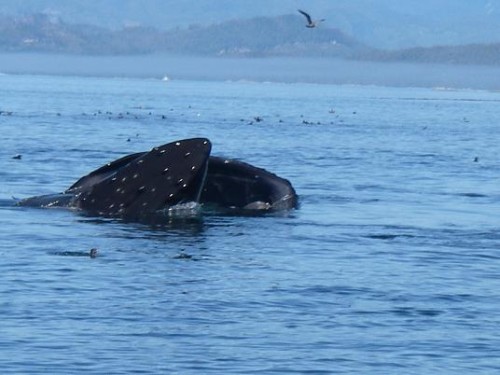
Little easier to tell that it is a humpback whale lunge feeding on a herring ball. Over the years it has become a much more common sight on the British Columbia coast as we frequently encounter a dozen or more whales on a day tour compared to one or two on a good day ten years ago. Still have a hard time convening my guests to ignore the humpbacks when there is a report of killer whales in the area. Saying “don’t worry they will be there when we return” does not seem to satisfy the need for photos.
BC waters have strange creatures?
On this day’s whale watching safari it is hard to tell from this photo what is happening. It is a marine mammal of some kind doing something. It is all a matter of perspective or the guides positioning of the boat maybe even the fault of the mammal for not considering the location of the boat. Clearer photo in tomorrow’s post…
Steller Sea Lion Haulout
Sea lions are a little larger than harbour seals. Their length is 2.4 to 2.8 m (7.75 to 9.25 ft) and they weight 1,133 kg (2,500 lbs.) and have average life span in the wild of 18 years for (males) and 30 (females). The sea lions have started to stay our viewing area all year but are more abundant in the summer. The rocky island haulouts in spring and fall may have over one hundred sea lions.
Overlooking seals
Harbour seals are found in British Columbia often in coastal waters, estuaries and river systems. The Pacific harbour seal inhabits the B.C. coast. The adult seal may reach a length of 1.6 – 1.9 m (5 –6 feet) and weigh from 60 – 120 kg (132- 265 lbs.), while ranging in colour from brownish to black with a speckled pattern. Your guide often takes them for granted because they are so abundant so remind them if you want a good picture.
Trapper Rick’s Grizzlies 3 of 3
When the grizzly bear eating the salmon is about fifty meters/yards across the river the guests get some good photos and memories to share around the dinner table back at the lodge. These are also the memories that have the guests return to the lodge for a second and third visit as well a recommend the Grizzly Bear Lodge to their friends.
Trapper Rick’s Grizzlies 2 of 3
Yesterday’s, today’s and tomorrow’s post photos are taken with a Pentax Optio Wpi 6MP and 3X Optical Zoom which does not have a “good zoom” lens for wildlife photo’s so with most cameras you would have much better photos. It is the feeling you get when watching grizzlies that are across the river from where you are sitting that is the adrenaline rush. You are not in a boat or a viewing stand but sitting on a rock bank across a river from the grizzlies. Trapper Rick knows these bears and they respond to his voice but he is still carries a gun to ensure your safety. The grizzly bear in the water is fishing for salmon and does manage to catch one…

